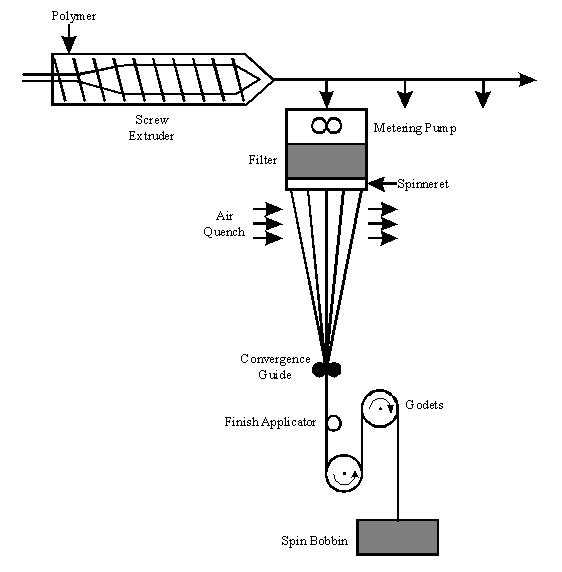
The polymer is melted with the aid of a screw extruder.
The use of the extruder allows several spinning positions to be supplied
by a single extruder via the use of a series of branching tubes.
The flow rate of the polymer to the spinneret is governed by metering pumps.
The metering pump is capable of feeding against high back pressures without
a change in the feed rate. This is important so that there is an
even flow of polymer into the spinnerets. Before the molten polymer
is spun, it flows through a filter which removes large particles along
with gel particles. These particles can block the holes in the spinneret
thus affecting polymer flow through it. The polymer then is processed
through the spinnerets. Continuous filament production spinnerets
can have up to 500 holes although they typically have 50 to 200.
However, those for tow may have several thousand. As molten polymer
passes though a spinneret hole, it is drawn away and attenuated by a draw-down
force applied by a windup roll; simultaneously its temperature rapidly
decreases. When spinning oxidation-sensitive polymers, it is useful
to use an inert gas blanket to prevent degradative reactions. Immediately
before the convergence guides, cool filtered air is blown across the thread
line at a controlled rate to encourage uniform cooling. After convergence,
the filament bundle may come into contact with a finish applicator, mixture
of lubricant and antistatic oils often containing small amounts of bioscides
and corrosion inhibitors. For continuous filament production, the
orientation of the spun yard is dependent upon the speed at which it is
forwarded or spun. Monofilament is produced at relatively low spinning
speeds due to difficulty in heat removal.
A table of typical melt spun fibers
Ref:
Kroschwitz, Jacqueline I. Encyclopedia of Polymer
Science and Engineering. Second Edition, Vol. 6. John Wiley & Sons.
New York. 1986 pp. 807-812.